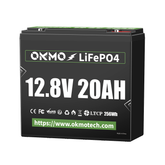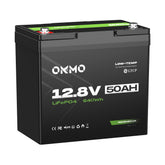Can I Mix Group 24 and Group 27 Batteries?
A Comprehensive Analysis of Lithium Battery Specifications and Compatibility

Lithium batteries (e.g., LiFePO4) are widely used in automotive, marine, and energy storage systems due to their high energy density and long lifespan. However, users often face confusion about the differences between Group 24, Group 27, and Group 31 batteries, as well as the risks of mixing them. This article delves into their specifications and addresses key concerns about series/parallel configurations and battery compatibility.
1. Specifications Comparison: Group 24, Group 27, and Group 31
Below are the physical dimensions and performance parameters of three common lithium battery groups (using LiFePO4 as an example):
| Specification | Dimensions (L×W×H, mm) | Typical Capacity (Ah) | Energy Density (Wh/L) | Common Applications |
|---|---|---|---|---|
| Group 24 | 260×173×227 | 80-100 Ah | 200-250 | Compact vehicles, small RVs |
| Group 27 | 306×173×227 | 100-120 Ah | 220-260 | Large RVs, marine vessels |
| Group 31 | 330×173×238 | 120-150 Ah | 240-280 | Commercial vehicles, off-grid systems |
Key Differences:
-
Size & Capacity: Group 31 > Group 27 > Group 24. Larger dimensions correlate with higher capacity.
-
Energy Density: Group 31 typically offers optimized space utilization, making it ideal for high-demand applications.

2. Risks and Solutions for Series/Parallel Configurations (2S4P/4S4P)
Users may attempt series/parallel configurations to increase voltage or capacity (e.g., 2S4P for a 24V system or 4S4P for 48V). However, the following risks must be addressed:
1. Root Causes of Issues
-
Internal Resistance Mismatch: Batteries from different brands or models vary in internal resistance, leading to uneven current distribution and localized overheating.
-
Capacity Imbalance: Lower-capacity batteries may charge/discharge faster, causing overcharging/over-discharging, reduced lifespan, or thermal runaway.
-
Self-Discharge Rate Differences: Voltage disparities increase during prolonged storage, potentially triggering BMS (Battery Management System) errors.
2. Solutions
-
Parameter Matching:
-
Use batteries of the same brand, model, and production batch.
-
Ensure capacity, internal resistance, and self-discharge rate differences are <5%.
-
-
Independent BMS:
-
Equip each battery group with a dedicated BMS to monitor cell voltage and temperature in real time.
-
-
Avoid Mixing Old and New Batteries: Aged batteries degrade performance and disrupt system balance.

3. Can Different Models or Brands of Batteries Be Mixed?
General Rule: Mixing is not recommended, but limited scenarios allow cautious exceptions.
1. Absolute Prohibitions
-
Different Chemistries: Mixing LiFePO4 with NMC (Nickel Manganese Cobalt) batteries is unsafe due to mismatched voltage curves.
-
Large Voltage/Capacity Gaps: For example, pairing Group 24 (12V 80Ah) directly with Group 31 (12V 150Ah) in parallel.
2. Limited Mixing Conditions
-
Voltage Consistency: All batteries must share the same nominal voltage (e.g., 12V).
-
DC-DC Isolation: Use DC-DC converters to isolate battery groups in series configurations, preventing reverse current flow.
-
Load Prioritization: Assign primary loads to high-capacity batteries and use smaller ones as backups (controlled via relays).
4. User Needs and Final Recommendations
-
Needs Assessment:
-
Capacity Expansion: Opt for a single high-capacity battery (e.g., Group 31) instead of mixing smaller units.
-
Voltage Upgrades: Choose pre-built high-voltage modules (e.g., 24V/48V) to minimize series-related risks.
-
-
Ultimate Recommendations:
-
Standardization: Use identical brands, models, and specifications to simplify maintenance and enhance safety.
-
Invest in Smart BMS: Advanced BMS with active balancing mitigates minor parameter mismatches.
-
Regular Monitoring: Check battery voltage and internal resistance monthly, replacing faulty units promptly.
-

Conclusion
Mixing Group 24, 27, and 31 batteries requires extreme caution. Series/parallel setups must prioritize parameter uniformity. For most users, selecting a single high-quality lithium battery paired with a reliable BMS is the optimal balance of performance and safety. If mixing is unavoidable, implement technical safeguards (e.g., isolation, independent BMS) and continuously monitor the system.









